Top 10+ eCommerce Technologies (2024): Use Cases & Examples
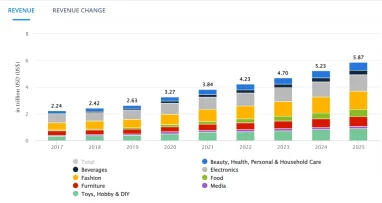
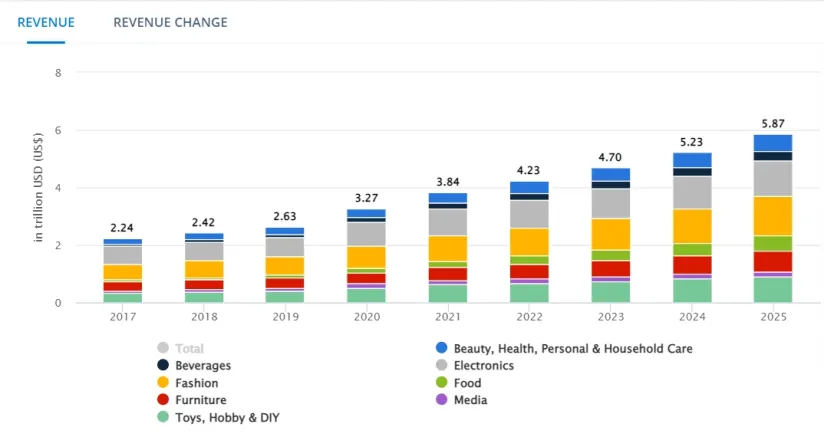
ECommerce sales in 2023 were close to $4 trillion, which demonstrates a greater economic activity than the entire G7 nation of Germany in the same year.1 Despite its giant market size, the eCommerce market is still expected to grow over 9% annually.
The issue is that, as shown in Figure 2, a few businesses dominate the eCommerce sector. If SMEs are to have a chance of competing with these conglomerates, they should embrace digital transformation and smart investments to:
- Lowering costs,
- Increasing customer satisfaction,
- And thus boosting profitability.
In order to help executives accomplish higher profitability, we present the top 10+ eCommerce technologies in this article.
Figure 2: Comparison of E-commerce giants vs SMEs’ market share (2022 vs 2018).
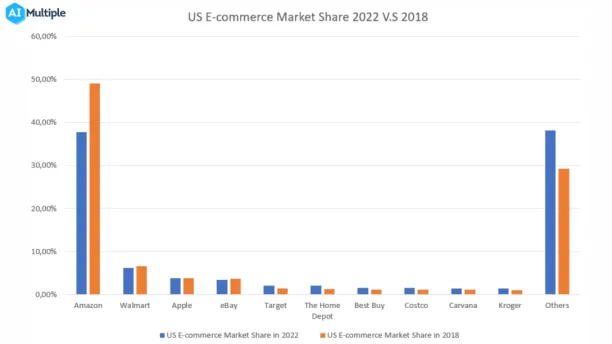
1. Chatbots and Intelligent virtual assistants (IVAs)
Chatbots and IVAs are effective tools for engaging with customers and reducing engagement costs.
Customers benefit from eCommerce such as they can purchase goods at any time and from any location. However, communications are something that eCommerce was missing.
Imagine making a purchase in a physical store. Salespeople inform customers about the advantages of the products, display alternatives and complementary items, and perhaps give advice to assist customers in making decisions.
Sales chatbots and IVAs can carry out the same functions on websites, mobile applications, and messaging services like WhatsApp. This sales strategy is known as conversational commerce, and according to PwC, customers are willing to pay up to 16% extra for such engaging services.
If you need more information about conversational commerce use cases you can read our 10 Conversational Commerce Use Cases for Different Industries article.
If you struggle to find a suitable chatbot vendor for your business you can check our 50+ Chatbot Companies To Deploy Conversational AI article.
2. Recommendation systems
Approximately 30% of consumers, according to a PwC survey, are willing to pay more for things that are suggested to them. Additionally, since users are continually inundated with suggestions, they are likely to appreciate personalized recommendations. The overall benefit is higher rates of engagement and boosted sales. For instance, McKinsey estimates that Amazon’s recommendation engine is responsible for more than one third of its sales.
In this regard, AIMultiple suggests executives to deploy behavioral analytics to better predict their customers’ wants. The below video presents how Netflix uses its recommendation system to enhance their customer satisfaction as well as its revenue.
Recommendation systems can also integrate with pop-ups for alerting users about some discounts or unchecked-out carts. Thus, eCommerce businesses can reduce the site leakages and cart abandonment.
3. AI-driven price monitoring tools
In highly competitive marketplaces, immediately changing pricing to match those employed by rivals can also significantly impact conversion rates and it helps you pounce on the small margins.
With the use of pricing tools, you can instantly evaluate your prices by comparing to those of your rivals’, as well as your stock levels and delivery policies.
With this knowledge, it is feasible to manually adjust the sales figures or, more frequently, set up the virtual store so that prices are adjusted based on changes in the competition. Such a strategy helps your eCommerce company to remain in competition.
For more on successful pricing check out the following articles:
- Guide to understanding price monitoring for the e-commerce sector
- Guide to finding the right price monitoring tool
- Guide to understanding price benchmarking
- Guide to improving pricing strategy.
If you need more information regarding AI use cases in eCommerce you can read our Top 19 AI Applications & Use Cases in E-Commerce and The Ultimate Guide Into Digital Shelf Analytics articles.
4. Web scraping
Web scraping is the process of extracting data from websites using a scraping bot or web scraping API. The technique is advantageous for eCommerce businesses because these companies produce:
- Customer data.
- Product data.
- Financial data.
Successful web scraping initiatives are beneficial for companies because they enable:
- Price comparison with competitors to stay competitive,
- Understanding customers’ purchase behavior and finding demanded products,
- Determining special users such as whales that bring significant income,
- Executing targeted ads,
- Conducting customer sentiment analysis and more.
Sponsored:
Bright Data’s Data Collector scrapes public data from targeted websites (see Figure 4). It allows companies to choose scraping frequency, such as real-time or scheduled. Scraped data is delivered in the desired format.
Bright Data provides datasets that do not require any programming or technical expertise for those who would rather skip data scraping and obtain the data directly (see Figure 4).
Figure 4: Service of Bright Data
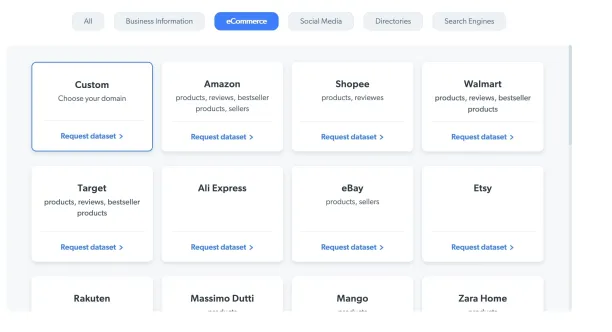
If you need more information regarding web scraping on eCommerce you can read our Web Scraping in e-Commerce: Use Cases & Challenges article.
5. Mobile apps
As of today, around 60% of e-Commerce sales are conducted on mobile apps. And as seen in Figure 5, the general trend suggests that the weight of mobile apps will be even more in the near future. Thus, having a custom mobile app is a beneficial eCommerce technology for the businesses.
Customers can interact with your brand continuously through apps, and they can learn about fresh and useful purchasing opportunities. Additionally, mobile apps provide customers a simple check-out process.
Figure 5: Sales channels mobile vs desktop
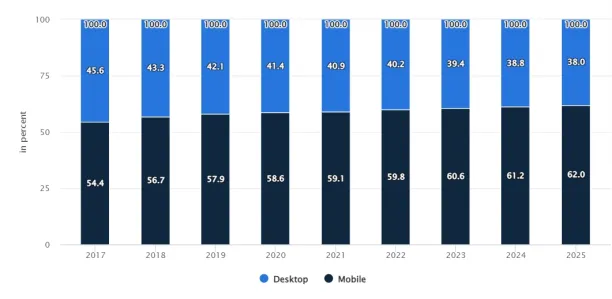
6. Supply chain visibility software
The entire supply chain, from delivery to warehouses, may be managed using supply chain visibility tools. These systems automate the issuance of invoices and track inventory.
While automating supply chain operations, Supply chain visibility software also helps to produce reports that can aid decision-making process. They generate financial reports and some supply chain management systems have ability to calculate corporate and product carbon footprint of the companies.
As a result, you may identify your present carbon emissions pain points and take steps to strengthen your environmental, social, and governance (ESG) posture. By doing so, you can increase your sales. For instance, a PwC survey revealed that more than 75% of consumers think about firms’ ESG policies before making purchases (see Figure 6).
Figure 6: Shoppers that concern ESG practices of businesses.
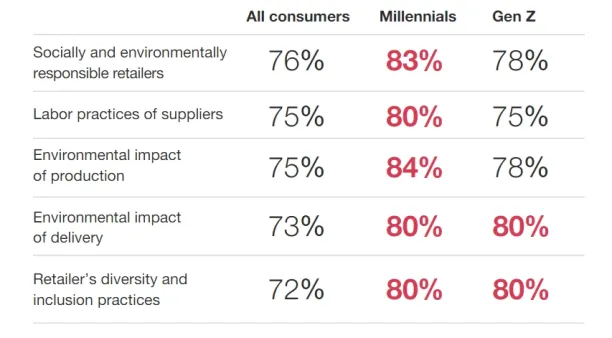
To learn more about best ESG practices you can read our Top 6 ESG Reporting Best Practices that Protect Your Business article.
Read this to learn more about supply chain visibility.
7. Warehouse automation technologies
Warehouse automation provides following benefits:
- Accurate scheduling of intermediate goods and final products
- Optimal inventory management
- Easier financial/environmental reporting
- Carbon footprint reduction and more.
Ecommerce companies can automate their warehouses with the following technologies:
- IoT: Smart lightning and HVAC systems optimize the storage conditions of the products while minimizing energy costs. Thus, you can reduce your carbon footprint up to 4% while reducing the number of waste products.
- Intelligent automation: Is the combination of NLP and RPA technologies. Order processing is automated by this technology, where NLP reads, comprehends, and converts orders into machine-readable formats. Following that, RPA shares the data with inventory management software and creates a shipping label based on the data.
- Cobots: Can work around the clock and package and palletize products. Thus, they can augment your workforce.
8. E-Wallets
An “e-wallet,” a kind of electronic card, is connected to a person’s bank account. It is utilized for online purchases on a computer or a smartphone.
The two major components of an e-wallet are software and data. The software component secures and encrypts the as personal information. The information component is a database that contains information that users have supplied, such as names, shipping addresses, preferred payment options, required payment amounts, credit or debit card information, etc.
E-wallets have three main benefits:
- They increase security.
- They ease the payment process thus reducing cart abandonment.
- Ease of refund which takes a few seconds only.
9. Check-out free systems
ECommerce technologies and data collected regarding customers is not optimizing online sales experience only but also in-store retail experience. Check-out free systems let customers to customers make in-store purchases without queuing thanks to following technologies:
- Computer vision
- Machine learning algorithms
- Smart sensors
- E-wallets or custom mobile apps.
For instance, the video below demonstrates how Amazon Go (check-out free system of Amazon) works.
10. Image search engines
Google image searches make up more than 22% of all queries, according to SemRush. Using images effectively is a key potential for businesses to succeed in e-commerce since Google Images is one of the most popular internet search engines.
Customers can use Google Images to search for products by capturing images of them and using reverse image search to find photos that are related to the product. Businesses can take advantage of this by uploading a file for each item they sell on their internet store.
By adding informative titles and alt texts to these photographs, they can make sure that the Google search crawlers know what the image is about. After images are indexed by Google, they will hopefully have a better Google position compared to competitors’ and increased B2C engagements.
Other Ecommerce technologies
Virtual reality
Another disadvantage of eCommerce vs. offline stores is that people cannot try or experience products before purchasing them. Virtual reality (VR) technology solves that issue by creating 3D artificial environments that users can explore and interact with. Thanks to VR, customers can virtually try out products, arrange furniture in their homes, and more.
For instance, the British shirt manufacturer Thomas Pink launched Fits.me, a VR online sales platform. By entering their body size, clients may use the VR platform to see how well the shirt fits them. Thomas Pink observed that the program led to an increase in sales.
For more on ecommerce technology, you can read the following articles:
- Top 10 eCommerce Trends Executives must be Aware of
- eCommerce Competitive Intelligence: 5 Benefits & Tools
- 12 Best Practices of eCommerce Market Intelligence
You can read our conversational commerce platforms benchmarking to find a suitable vendor you can cooperate with.
If you need more information concerning eCommerce technologies, please book a call. We are ready to answer your questions if you can answer a couple questions about your AIMultiple experience. We are currently offering this service for businesses based in the US or EU.
Sources
Source: Figure 1
- 1. eCommerce – Worldwide. Statista. October 2023. Retrieved January 1, 2023

Cem has been the principal analyst at AIMultiple since 2017. AIMultiple informs hundreds of thousands of businesses (as per similarWeb) including 60% of Fortune 500 every month.
Cem's work has been cited by leading global publications including Business Insider, Forbes, Washington Post, global firms like Deloitte, HPE, NGOs like World Economic Forum and supranational organizations like European Commission. You can see more reputable companies and media that referenced AIMultiple.
Throughout his career, Cem served as a tech consultant, tech buyer and tech entrepreneur. He advised businesses on their enterprise software, automation, cloud, AI / ML and other technology related decisions at McKinsey & Company and Altman Solon for more than a decade. He also published a McKinsey report on digitalization.
He led technology strategy and procurement of a telco while reporting to the CEO. He has also led commercial growth of deep tech company Hypatos that reached a 7 digit annual recurring revenue and a 9 digit valuation from 0 within 2 years. Cem's work in Hypatos was covered by leading technology publications like TechCrunch and Business Insider.
Cem regularly speaks at international technology conferences. He graduated from Bogazici University as a computer engineer and holds an MBA from Columbia Business School.
To stay up-to-date on B2B tech & accelerate your enterprise:
Follow on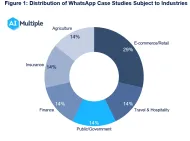
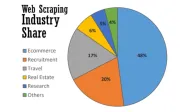
Comments
Your email address will not be published. All fields are required.